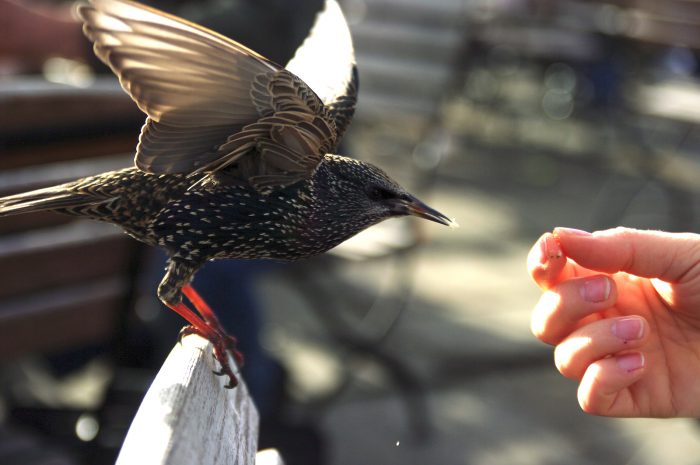*Editor’s Note: This piece is part of a series—lucky you. Head to the author’s profile to continue reading, or start with Chapter One.
~
Not too long after Passover, I open the cabinet below the one where I find the china.
It’s close to the floor and I kneel down to see what’s on the bottom shelf. When I open the white cupboard doors, I see casseroles, serving dishes, glass bowls, fancy cake plates, hand painted ceramic fruit trays. It’s like a museum of who my mom used to be.
Memories flood back as I pick up her cookware that nobody has used, or even seen, for decades. I remember parties she hosted when I was a child, and how my sister and brother and I would peek down from the top of the stairs. Clinking glasses, laughter, and a roomful of conversation enchanted us, like a fairy tale. My mom stayed up late after her guests left. She’d clear the table and wash all the dishes, leaving the wine goblets for last, since they couldn’t go into the dishwasher. Then she’d clean the crumbs off the tablecloth on the dining room table with a special brush, and shake out the heavy white linen.
I find an old brass challah tray and an embroidered white cloth that was used to cover the challah—the braided bread we’d eat on Friday nights after we lit candles and said prayers. There was a time, when I was young, when my mother made challah every Friday night.
I start to remember who she was, before she became this mother who lived in the den, needing us to change her diaper, cursing at us when we did. It had been so long—33 years since the aneurysm, and I’d been watching her die in increments all that time—that all other memories of her had been obliterated.
Even before that, though, I never had a stable mom. I’m here in her kitchen in the home she created for her family and now, thanks to the whispers at the end of her life—those words that changed from hate to love—I’m starting to feel like I have a mom again. No. I’m starting to feel like I have a mom for the first time in my life.
All I ever wanted, all my life, was to stop losing my mom. Inside me, on a level far below my conscious mind, some part of me was always braced for her to leave again—another suicide attempt, another visit to intensive care. Something in my cells was always begging, “Stop going away—stop almost dying.”
It’s over now. She’s gone. And me—I’m back in this house, this kitchen, and for once, I’m not counting the days until I leave. I decide to stay.
I have work that’s portable and I set up an office in my sister Laurie’s old bedroom. I clear out the boxes that are stored there, find an old card table. It becomes my desk. Familiar orange flowered wallpaper greets me each day. I look out the window to watch the maple and oak trees unfurl into green as April turns into May.
My father starts to comb his hair again, starts getting dressed before he comes downstairs for breakfast. One day after I’ve been home a few weeks, he comes with me when I go to the library. As we’re getting ready to leave the house I ask him how long he thinks he’ll be there. “Oh, five minutes.”
We walk in and the librarians beam with smiles and genuine pleasure. “Mr. Seidman, where have you been?” Two hours later, we get back in the car and head home. He tells me, “It’s the first time I’ve been to the library since your mother died.”
Over the next few months, I find a casserole dish I love and bake chicken dinners in it. It’s a gorgeous piece of stoneware of deep orange and green earth tones. Something I might have bought for myself. That’s who my mother used to be. It had been so long that I’d forgotten, completely.
I find bright yellow cloth napkins to use for holiday meals when I cook for family gatherings. I love opening the cabinet to discover new bowls and baking dishes. What treasures will I unearth today? I stay eight months, cooking in that kitchen, remembering who my mother was.
Through all the years I’ve been visiting Cleveland and this house since I graduated high school, I’ve barely cooked in this kitchen. It’s as if the kitchen was a shrine to who my mother used to be, not a living place. I’ve boiled water for tea, heated up cans of soup, but almost never used the oven, let alone opened the cupboard where all her cookware lives.
It all changes this summer. I buy cardamom pods, fresh ginger root, coriander, and turmeric. I open one of her cookbooks and find a recipe for curried squash soup, and search for her soup pot. It’s way in the back of the cupboard, behind the smaller one my dad uses to boil his spaghetti noodles.
I experiment with another recipe that I bake in her casserole. Every time I pick it up, admire the swirling colors, feel its weight, and notice how it’s both sturdy and beautiful, this other Mom comes alive for me.
Not the one who spent so much time in the ICU in a coma, not the one whose raspy whisper called out from the hospital bed in the den, not the one whose diaper I changed, or the one I visited in Hannah Pavilion when I was a child. Instead, I see the mother she wanted to be, the mother she would have been, if she’d been able.
I stand in her kitchen, stirring a pot on the stove, gathering onions, garlic, and ginger to add to the curried sweet potatoes that will go in the oven. I thought I had forgiven my mother long ago for not being a mother I could count on, or talk to, but what I experience now is beyond forgiveness. I pull the sharpest chopping knife out from the knife rack on the counter and smash a clove of garlic with it. I peel the paper-thin shell and chop chop chop it fine on the cutting board.
My mother loved to cook. My mother stopped cooking, stopped eating solid food, stopped walking, swimming, reading, and wearing most of her dresses and jewelry for decades before she died. But in the end, she also stopped saying “I hate you” long enough for something else to slip in.
I smash three more cloves of garlic with the flat blade of the knife, chop until the pieces are small as grains of sand. I slide the garlic off the cutting board and brush it into the waiting pan—a thousand starlings rise into the night.
I’m standing at the stove in my mother’s kitchen, listening to garlic popping and crackling as it sautés in olive oil. Every starling carries a morsel in its beak. I can see each one—its density, its weight—the heavy, sticky memory like tar. The starlings come back and clean every corner of the house.
I’ve gone through the house before, dozens of times, with a broom and a dustpan, a vacuum cleaner and a mop, but the stubborn residues of sadness and pain wouldn’t leave. Now the starlings are here. It’s all light as feathers in their mouths.
The garlic’s in the copper-colored casserole, mixed with ginger, cardamom, black and white pepper. The food simmers. Soon, very soon, it will be ready to eat.
~
To the reader:
Memories unfold in layers. I can’t explain where the starlings came from in the writing process…they just emerged. Yet I do know that metaphors arise organically when it’s the only way to articulate an experience. What the starlings convey—an unexpected freedom from a past that had long felt like a burden, and the sense that forces beyond the human were part of that transformation—felt emotionally true to me when I wrote it. I wonder when you’ve had that experience—something in your life transforming in a way that felt like a paradigm shift? Have you written about it using an image or a metaphor? Try it, and see what happens!












Read 5 comments and reply